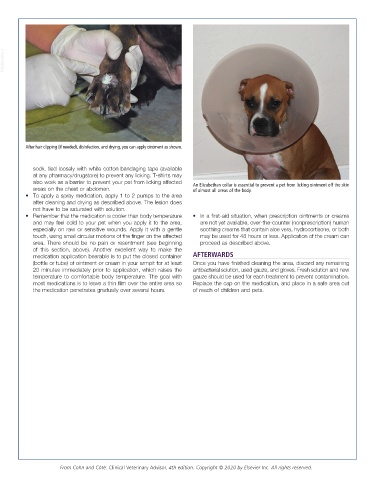Page 3203 - Cote clinical veterinary advisor dogs and cats 4th
P. 3203
VetBooks.ir
After hair clipping (if needed), disinfection, and drying, you can apply ointment as shown.
sock, tied loosely with white cotton bandaging tape (available
at any pharmacy/drugstore) to prevent any licking. T-shirts may
also work as a barrier to prevent your pet from licking affected
areas on the chest or abdomen. An Elizabethan collar is essential to prevent a pet from licking ointment off the skin
of almost all areas of the body.
• To apply a spray medication, apply 1 to 2 pumps to the area
after cleaning and drying as described above. The lesion does
not have to be saturated with solution.
• Remember that the medication is cooler than body temperature • In a first-aid situation, when prescription ointments or creams
and may feel cold to your pet when you apply it to the area, are not yet available, over-the-counter (nonprescription) human
especially on raw or sensitive wounds. Apply it with a gentle soothing creams that contain aloe vera, hydrocortisone, or both
touch, using small circular motions of the finger on the affected may be used for 48 hours or less. Application of the cream can
area. There should be no pain or resentment (see beginning proceed as described above.
of this section, above). Another excellent way to make the
medication application bearable is to put the closed container AFTERWARDS
(bottle or tube) of ointment or cream in your armpit for at least Once you have finished cleaning the area, discard any remaining
20 minutes immediately prior to application, which raises the antibacterial solution, used gauze, and gloves. Fresh solution and new
temperature to comfortable body temperature. The goal with gauze should be used for each treatment to prevent contamination.
most medications is to leave a thin film over the entire area so Replace the cap on the medication, and place in a safe area out
the medication penetrates gradually over several hours. of reach of children and pets.
From Cohn and Côté: Clinical Veterinary Advisor, 4th edition. Copyright © 2020 by Elsevier Inc. All rights reserved.

